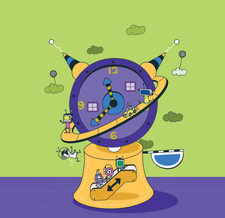Creating mind maps with Labyrinth
Networking Thoughts

The Labyrinth mind mapper lets you collect and organize your thoughts and ideas without major detours.
Gathering and structuring your ideas is not always easy. Many people find a blank sheet of paper useful for jotting down their thoughts and brainstorming results. But, if you want to play with the products of your imagination or have them handy at some point in the future, your most effective option is mind mapping (see the box "Stroke for Stroke").
Software such as Labyrinth [1] hugely simplifies the process of creating mind maps by first helping you collect the ideas and then saving the structures you developed for a new session. If necessary, you can edit the graphic by colorizing individual nodes on the map or adding images. Labyrinth also lets you change the elements in almost any way to obtain a new perspective on your "mental landscape."
Installation
Ubuntu has Labyrinth in its repositories, so you can install the application easily via the graphical package manager. For an even faster approach, you can type the following command at the command line:
[...]
Buy this article as PDF
(incl. VAT)
Buy Linux Magazine
Subscribe to our Linux Newsletters
Find Linux and Open Source Jobs
Subscribe to our ADMIN Newsletters
Support Our Work
Linux Magazine content is made possible with support from readers like you. Please consider contributing when you’ve found an article to be beneficial.

News
-
Two New Distros Adopt Enlightenment
MX Moksha and AV Linux 25 join ranks with Bodhi Linux and embrace the Enlightenment desktop.
-
Solus Linux 4.8 Removes Python 2
Solus Linux 4.8 has been released with the latest Linux kernel, updated desktops, and a key removal.
-
Zorin OS 18 Hits over a Million Downloads
If you doubt Linux isn't gaining popularity, you only have to look at Zorin OS's download numbers.
-
TUXEDO Computers Scraps Snapdragon X1E-Based Laptop
Due to issues with a Snapdragon CPU, TUXEDO Computers has cancelled its plans to release a laptop based on this elite hardware.
-
Debian Unleashes Debian Libre Live
Debian Libre Live keeps your machine free of proprietary software.
-
Valve Announces Pending Release of Steam Machine
Shout it to the heavens: Steam Machine, powered by Linux, is set to arrive in 2026.
-
Happy Birthday, ADMIN Magazine!
ADMIN is celebrating its 15th anniversary with issue #90.
-
Another Linux Malware Discovered
Russian hackers use Hyper-V to hide malware within Linux virtual machines.
-
TUXEDO Computers Announces a New InfinityBook
TUXEDO Computers is at it again with a new InfinityBook that will meet your professional and gaming needs.
-
SUSE Dives into the Agentic AI Pool
SUSE becomes the first open source company to adopt agentic AI with SUSE Enterprise Linux 16.

